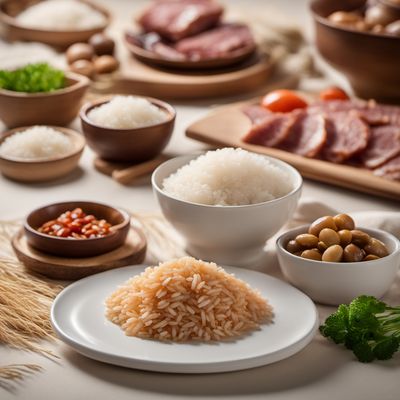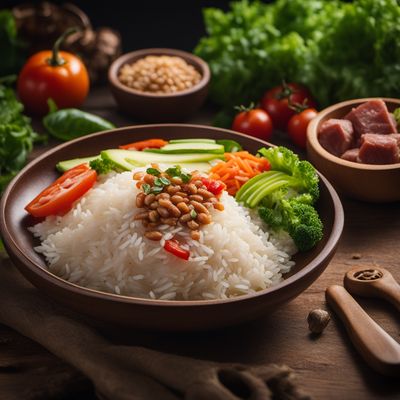
Ingredient
Dolma
Delightful Stuffed Goodness
Dolma is a culinary delight that showcases a harmonious blend of textures and flavors. The vegetables or grape leaves are carefully stuffed with a fragrant mixture of rice, herbs, and spices, resulting in a dish that is both visually appealing and delicious. The filling is often vegetarian, but variations with meat are also popular. Dolma can be enjoyed as an appetizer, side dish, or even a main course, and it is a testament to the rich culinary heritage of the regions it originates from.
Origins and history
Dolma has a long and fascinating history that dates back thousands of years. Its origins can be traced to the ancient civilizations of the Mediterranean and the Middle East, where it was a staple in the diets of various cultures. The word 'dolma' itself is derived from the Turkish word 'dolmak,' which means 'to be stuffed.' Over time, dolma has become an integral part of the culinary traditions of countries like Turkey, Greece, Iran, and Armenia, each adding their own unique twist to the dish. Today, dolma is cherished for its cultural significance and is enjoyed in many parts of the world.
Nutritional information
Dolma is a nutritious dish that provides a good amount of dietary fiber, vitamins, and minerals. The vegetables used in dolma, such as bell peppers, zucchini, or grape leaves, contribute to its nutritional value by offering essential nutrients like vitamin C, vitamin A, and potassium. The rice filling adds carbohydrates and a modest amount of protein to the dish. However, the nutritional content can vary depending on the specific ingredients and cooking methods used.
How to select
When selecting dolma, look for vegetables or grape leaves that are fresh, vibrant, and free from blemishes or tears. The grape leaves should be pliable and not too brittle. If purchasing pre-packaged dolma, check the expiration date and ensure that the packaging is intact. Additionally, consider the reputation and quality of the brand or supplier when making your selection.
Storage recommendations
To store dolma, place any leftovers in an airtight container and refrigerate. Consume within 2-3 days to maintain its freshness and quality. If you have made dolma from scratch and have uncooked leftovers, you can freeze them for later use. Simply arrange the dolma in a single layer on a baking sheet and freeze until solid. Then transfer them to a freezer-safe container or bag, and they can be stored for up to 3 months. Thaw frozen dolma in the refrigerator before reheating or cooking.
Preparation tips
Dolma can be prepared by carefully stuffing the vegetables or grape leaves with a mixture of cooked rice, herbs, and spices. The filling can be customized to suit personal preferences, with options like adding ground meat, nuts, or dried fruits. Dolma can be cooked by simmering in a flavorful broth, baking in the oven, or even grilling for a smoky twist. Serve dolma as an appetizer, side dish, or main course, and garnish with a squeeze of lemon juice or a dollop of yogurt for added freshness.
Culinary uses
Dolma is a versatile dish that can be enjoyed in various culinary applications. It is commonly served as an appetizer or meze, alongside other small plates, in Middle Eastern and Mediterranean cuisines. Dolma can also be incorporated into main courses, such as being served with yogurt sauce and rice pilaf. In some regions, dolma is a traditional dish prepared for festive occasions or celebrations. Its popularity has spread beyond its place of origin, and it can now be found in many international restaurants and food markets.
Availability
Dolma is commonly available and cultivated in countries like Turkey, Greece, Iran, Armenia, and other parts of the Middle East and the Mediterranean region. It has also gained popularity in various other countries around the world, thanks to its delicious flavors and cultural significance.
More ingredients from this category

Milk rice
Creamy Delight: Exploring the Richness of Milk Rice

Rice and meat meal
Savory Rice Delight

Paella
The Iconic Spanish Delight: Paella

Rice and vegetables meal
Harmony on a Plate: Rice and Vegetable Medley

Risotto
Creamy Delight: Unveiling the Magic of Risotto

Rice, fish/seafood and vegetable based dishes
A Symphony of Flavors: Exploring the Delights of Rice, Fish/Seafood, and Vegetable Based Dishes

Rice pudding
Creamy Delight: Exploring the World of Rice Pudding

Rice, meat, and vegetables meal
Wholesome Harmony: A Nutrient-Rich Medley of Rice, Meat, and Vegetables

Nasi goreng
"Indonesian Delight: Exploring the Flavors of Nasi Goreng"